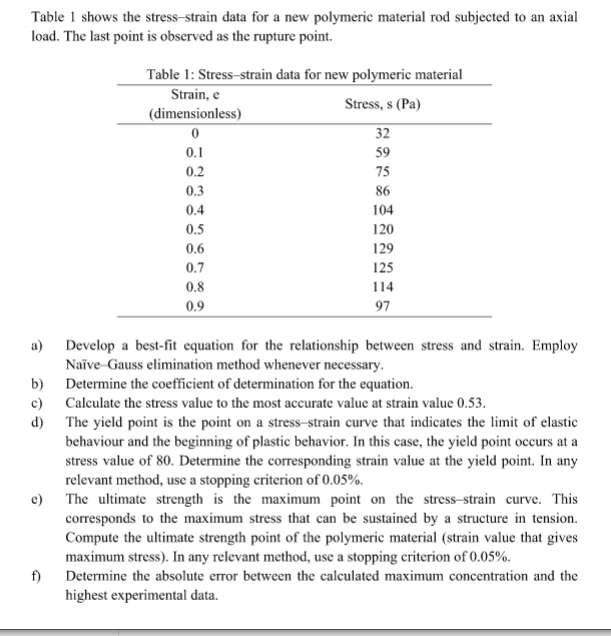Table 1 shows the stress-strain data for a new polymeric material rod subjected to an axial load. The last point is observed as the rupture point. Table 1: Stress-strain data for new polymeric material Strain, e Stress, s (Pa) (dimensionless) 32 0.1 59 0.2 75 0.3 86 0.4 104 0.5 120 0.6 129 0.7 125 0.8 114 0.9 97 a) Develop a best-fit equation for the relationship between stress and strain. Employ Naïve-Gauss elimination method whenever necessary. Determine the coefficient of determination for the equation. Calculate the stress value to the most accurate value at strain value 0.53. b) c)
Table 1 shows the stress-strain data for a new polymeric material rod subjected to an axial load. The last point is observed as the rupture point. Table 1: Stress-strain data for new polymeric material Strain, e Stress, s (Pa) (dimensionless) 32 0.1 59 0.2 75 0.3 86 0.4 104 0.5 120 0.6 129 0.7 125 0.8 114 0.9 97 a) Develop a best-fit equation for the relationship between stress and strain. Employ Naïve-Gauss elimination method whenever necessary. Determine the coefficient of determination for the equation. Calculate the stress value to the most accurate value at strain value 0.53. b) c)
Algebra & Trigonometry with Analytic Geometry
13th Edition
ISBN:9781133382119
Author:Swokowski
Publisher:Swokowski
Chapter7: Analytic Trigonometry
Section7.6: The Inverse Trigonometric Functions
Problem 91E
Related questions
Question
d) e) f) using numerical methods, please provide full solution

Transcribed Image Text:Table 1 shows the stress-strain data for a new polymeric material rod subjected to an axial
load. The last point is observed as the rupture point.
Table 1: Stress-strain data for new polymeric material
Strain, e
Stress, s (Pa)
(dimensionless)
32
0.1
59
0.2
75
0.3
86
0.4
104
0.5
120
0.6
129
0.7
125
0.8
114
0.9
97
Develop a best-fit equation for the relationship between stress and strain. Employ
Naïve-Gauss elimination method whenever necessary.
a)
b) Determine the coefficient of determination for the equation.
c)
Calculate the stress value to the most accurate value at strain value 0.53.
d) The yield point is the point on a stress-strain curve that indicates the limit of elastic
behaviour and the beginning of plastic behavior. In this case, the yield point occurs at a
stress value of 80. Determine the corresponding strain value at the yield point. In any
relevant method, use a stopping criterion of 0.05%.
e) The ultimate strength is the maximum point on the stress-strain curve. This
corresponds to the maximum stress that can be sustained by a structure in tension.
Compute the ultimate strength point of the polymeric material (strain value that gives
maximum stress). In any relevant method, use a stopping criterion of 0.05%.
f)
Determine the absolute error between the calculated maximum concentration and the
highest experimental data.
Expert Solution
This question has been solved!
Explore an expertly crafted, step-by-step solution for a thorough understanding of key concepts.
This is a popular solution!
Trending now
This is a popular solution!
Step by step
Solved in 5 steps

Recommended textbooks for you

Algebra & Trigonometry with Analytic Geometry
Algebra
ISBN:
9781133382119
Author:
Swokowski
Publisher:
Cengage

Algebra & Trigonometry with Analytic Geometry
Algebra
ISBN:
9781133382119
Author:
Swokowski
Publisher:
Cengage